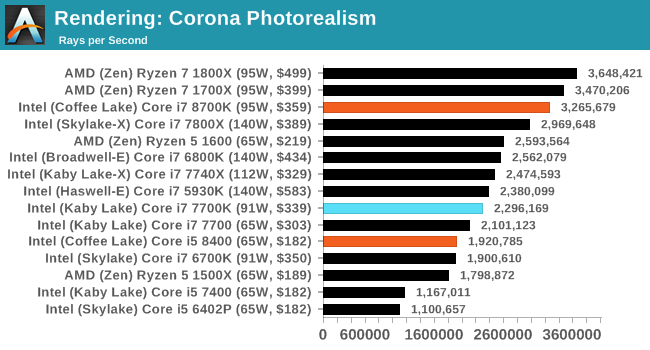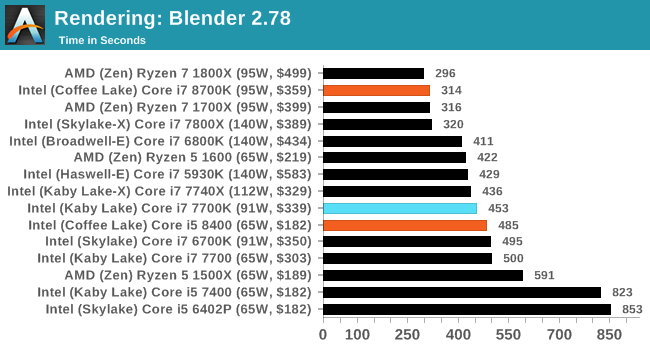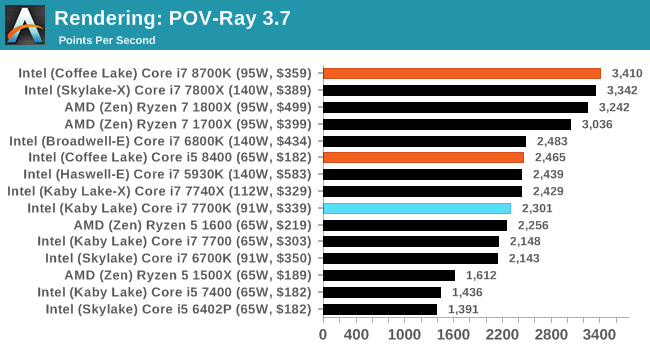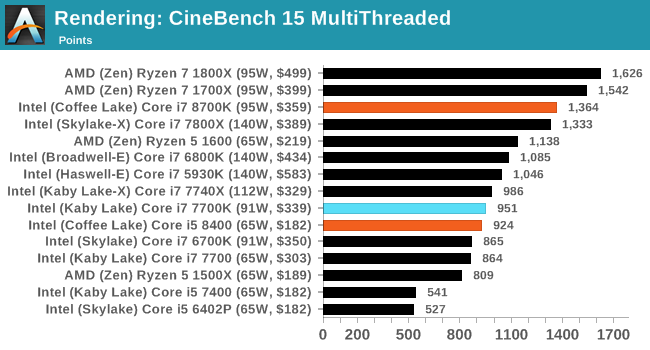The AnandTech Coffee Lake Review: Initial Numbers on the Core i7-8700K and Core i5-8400
by Ian Cutress on October 5, 2017 9:00 AM EST- Posted in
- CPUs
- Intel
- Core i5
- Core i7
- Core i3
- 14nm
- Coffee Lake
- 14++
- Hex-Core
- Hyperthreading
Benchmarking Performance: CPU Rendering Tests
Rendering tests are a long-time favorite of reviewers and benchmarkers, as the code used by rendering packages is usually highly optimized to squeeze every little bit of performance out. Sometimes rendering programs end up being heavily memory dependent as well - when you have that many threads flying about with a ton of data, having low latency memory can be key to everything. Here we take a few of the usual rendering packages under Windows 10, as well as a few new interesting benchmarks.
All of our benchmark results can also be found in our benchmark engine, Bench.
Corona 1.3: link
Corona is a standalone package designed to assist software like 3ds Max and Maya with photorealism via ray tracing. It's simple - shoot rays, get pixels. OK, it's more complicated than that, but the benchmark renders a fixed scene six times and offers results in terms of time and rays per second. The official benchmark tables list user submitted results in terms of time, however I feel rays per second is a better metric (in general, scores where higher is better seem to be easier to explain anyway). Corona likes to pile on the threads, so the results end up being very staggered based on thread count.

With more threads on display, the Core i7-8700K gets ahead of the previous mainstream Core i7 parts. The frequency difference over the Skylake-X processor gives an extra +10% performance, but the 16-thread parts from AMD win out overall.
Blender 2.78: link
For a render that has been around for what seems like ages, Blender is still a highly popular tool. We managed to wrap up a standard workload into the February 5 nightly build of Blender and measure the time it takes to render the first frame of the scene. Being one of the bigger open source tools out there, it means both AMD and Intel work actively to help improve the codebase, for better or for worse on their own/each other's microarchitecture.

Blender seems to separate very nicely into core counts, with six cores from Intel matching eight cores from AMD.
LuxMark v3.1: Link
As a synthetic, LuxMark might come across as somewhat arbitrary as a renderer, given that it's mainly used to test GPUs, but it does offer both an OpenCL and a standard C++ mode. In this instance, aside from seeing the comparison in each coding mode for cores and IPC, we also get to see the difference in performance moving from a C++ based code-stack to an OpenCL one with a CPU as the main host.

POV-Ray 3.7.1b4: link
Another regular benchmark in most suites, POV-Ray is another ray-tracer but has been around for many years. It just so happens that during the run up to AMD's Ryzen launch, the code base started to get active again with developers making changes to the code and pushing out updates. Our version and benchmarking started just before that was happening, but given time we will see where the POV-Ray code ends up and adjust in due course.

Cinebench R15: link
The latest version of CineBench has also become one of those 'used everywhere' benchmarks, particularly as an indicator of single thread performance. High IPC and high frequency gives performance in ST, whereas having good scaling and many cores is where the MT test wins out.


CineBench R15 in single thread mode can take the Core i7-8700K by the horns and drag it to be the best performing chip ever tested.










222 Comments
View All Comments
FireSnake - Thursday, October 5, 2017 - link
Awesome revies! Let's read...prisonerX - Thursday, October 5, 2017 - link
No need, here is a quick summary: "Intel blind panic."StevoLincolnite - Thursday, October 5, 2017 - link
At-least they have finally soundly beat my 3930K in the mainstream after 6 years.Still. No point me upgrading just yet.
mapesdhs - Friday, October 6, 2017 - link
Even then there's an interesting option if you want threaded performance; I just upgraded to a XEON E5-2680 v2 (IB-EP) for 165 UKP. Lower 1T speed for sure, but MT should be the same or better as a 3930K @ 4.8. No oc means more stable, less heat/noise/power, and being IB-based means it ups the slots to PCIe 3.0. Not a relevant choice for gaming, but a possibility for those doing VMs, rendering, etc., and just want to get by for a little while longer.Breit - Friday, October 6, 2017 - link
OR search for an XEON E5-1680v2... :)It's an Ivy Bridge-E 8c/16t chip that will fit in Sandy Bridge-E mainboards (x79) and has an unlocked multiplier opposed to this E5-2680v2. So with this you won't lose your overclocking ability.
But in the end, I guess that the greatly reduced power draw and the more "modern" platform from an i7-8700K system compared to the x79 platform will give it the edge here.
mapesdhs - Monday, October 9, 2017 - link
Very interesting that the 1680 v2 is unlocked, I didn't know that.Alas though, availability of the 1680 v2 is basically zero, whereas the 2680 v2 is very easy to find, and the cost of 1680 v2s which are available (outside the UK) is extremely high (typical BIN of 600 UKP, normal auction start price of 350 UKP, completed listings only shown for BIN items which were purchased for between 500 and 600 UKP). By contrast, I bought several 2680 v2s for 165 UKP each. Testing on a P9X79 WS (all-core turbo of 3.1) gives a very impressive 15.44 for CB 11.5, and 1381 for CB R15 which is faster than a stock 8700K (for reference, the 1680 v2 scores 1230 for CB R15). Note the following page on AT has a very handy summary of all the turbo bin levels:
https://www.anandtech.com/show/7852/intel-xeon-e52...
So, I'm very pleased with the 2680 v2 purchase, it's faster than my 3930K @ 4.8, runs with very low temps, much lower power draw, hence less heat, less fan noise and since it's not oc'd it'll be solidly reliable (this particular test system will eventually be in an office in India, so power/heat/reliability is critical). For the target systems in question, it's a great solution. Only thing I noticed so far is it didn't like me trying to set a 2133 RAM speed, but it worked ok at 1866; I can probably tighten the timings instead, currently just at 9/11/10/28/2T (GSkill 32GB kit, 8x4GB).
The 4930K I have though will go into my gaming system (R4E), since I don't mind the oc'ing fun, higher noise, etc., but it's not a system I'll use for converting video, for that I have a 6850K.
Ian.
MrSpadge - Friday, October 6, 2017 - link
Full throttle: yes. Panic: no. Blind: no.Zingam - Saturday, October 7, 2017 - link
Can you buy it? No? Paper launch of Unobtanium 8000? -> panic, PR propaganda bullshit and dirty Intel marketing tactics as usual targeted at lamer fanboys.This comment is written by an Intel user! ;)
prisonerX - Saturday, October 7, 2017 - link
We've got enough dumb Intel apologists here already, thanks.coolhardware - Sunday, October 8, 2017 - link
The i7-8700 is *finally* going to replace my trusty i5-2500K.Ordered my 8700 on Amazon http://amzn.to/2y9IamG ($319) and looking forward to a nice upgrade :-) That is a lot of CPU for the money IMHO.
Kudos to AMD for bringing competition back to the CPU market!